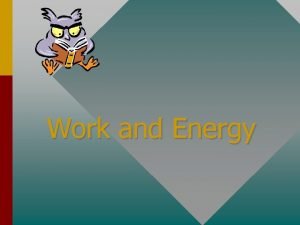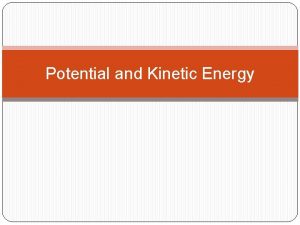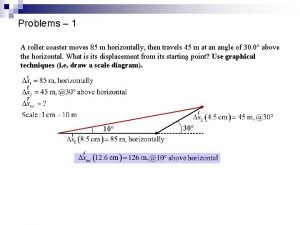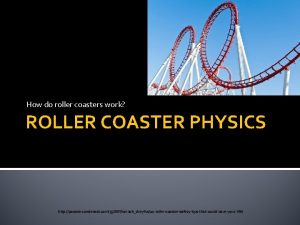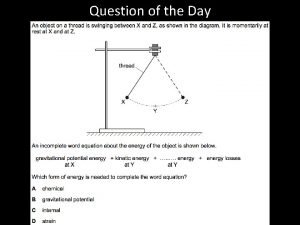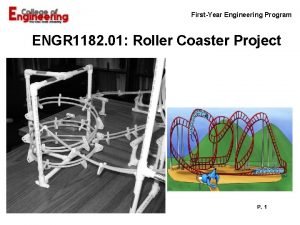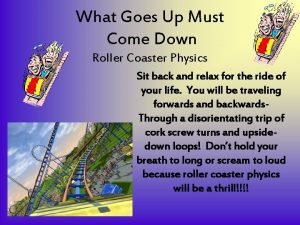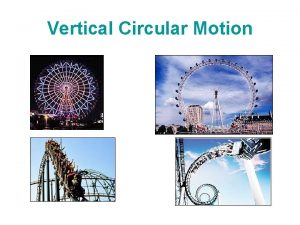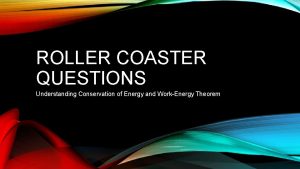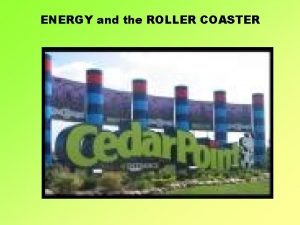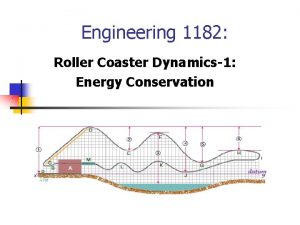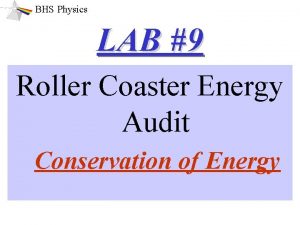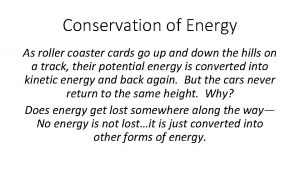Work and Energy The Ninja a roller coaster















- Slides: 15

Work and Energy

The Ninja, a roller coaster at Six Flags over Georgia, has a height of 122 ft and a speed of 52 mi/h. The potential energy due to its height changes into kinetic energy of motion.

Goals: • Define kinetic energy and potential energy, along with the appropriate units in each system. • Describe the relationship between work and kinetic energy, and apply the WORKENERGY THEOREM.

Energy is anything that can be converted into work; i. e. , anything that can exert a force through a distance Energy is the capability for doing work.

Potential Energy: Stored energy. A suspended weight A stretched bow

Example Problem: What is the potential energy of a 50 -kg person in a skyscraper if he is 480 m above the street below? Gravitational Potential Energy What is the P. E. of a 50 -kg person at a height of 480 m? U = mgh = (50 kg)(9. 8 m/s 2)(480 m) U = 235 k. J

Kinetic Energy: Energy of motion. If an object is moving, it has kinetic energy. (Mass with velocity) A speeding car or a space rocket

Examples of Kinetic Energy What is the kinetic energy of a 5 -g bullet traveling at 200 m/s? 5 g 200 m/s K = 100 J What is the kinetic energy of a 1000 -kg car traveling at 14. 1 m/s? K = 99. 4 k. J

Work and Kinetic Energy A resultant force changes the velocity of an object and does work on that object. vf x v o m F

The Work-Energy Theorem Work is equal to the change in ½mv 2 If we define kinetic energy as ½mv 2 then we can state a very important physical principle: The Work-Energy Theorem: The work done by a resultant force is equal to the change in kinetic energy that it produces.

Example 1: A 20 -g projectile strikes a mud bank, going a distance of 6 cm before stopping. Find the stopping force F if the initial velocity is 80 m/s. 6 cm 80 m/s 0 x 2 2 Work = ½ mvf - ½ mvi F x= - ½ mvi 2 F=? F (0. 06 m) cos 1800 = - ½ (0. 02 kg)(80 m/s)2 F (0. 06 m)(-1) = -64 J F = 1067 N Work to stop bullet = change in K. E. for bullet

Example 2: A bus slams on brakes to avoid an accident. The tread marks of the tires are 25 m long. If m = 0. 7, what was the speed before applying brakes? Work = DKE Work = F(cos q) x Ff = m. FN = m mg Work = - m mg x -½ mv -m mg x DKEi 2==Work 25 m F f 0 DKE = ½ mvf 2 - ½ mvi 2 vi = 2(0. 7)(9. 8 m/s 2)(25 m) 2 mgx vi = 18. 5 m/s

Power is defined as the rate at which work is done: (P = W/t ) Power of 1 W is work done at rate of 1 J/s

Example of Power What power is consumed in lifting a 70 -kg robber 1. 6 m in 0. 50 s? Power Consumed: P = 2220 W

Example 3: A 100 -kg cheetah moves from rest to 30 m/s in 4 s. What is the power? Recognize that work is equal to the change in kinetic energy: m = 100 kg Power Consumed: P = 1. 22 k. W
 The ninja roller coaster
The ninja roller coaster Potential and kinetic energy examples
Potential and kinetic energy examples A moderate force will break an egg
A moderate force will break an egg Tbri activities
Tbri activities Digestive system roller coaster
Digestive system roller coaster A football player runs directly down the field for 35 m
A football player runs directly down the field for 35 m Roller coaster polynomial project
Roller coaster polynomial project Roller coaster physics video
Roller coaster physics video Everyday edit answers
Everyday edit answers A ball is held above the ground and then is dropped
A ball is held above the ground and then is dropped Performance task: roller coaster design
Performance task: roller coaster design Funderstanding roller coaster
Funderstanding roller coaster Roller coaster plot diagram
Roller coaster plot diagram Roller coaster design project
Roller coaster design project Rekenrek roller coaster
Rekenrek roller coaster As a roller coaster goes downhill
As a roller coaster goes downhill
